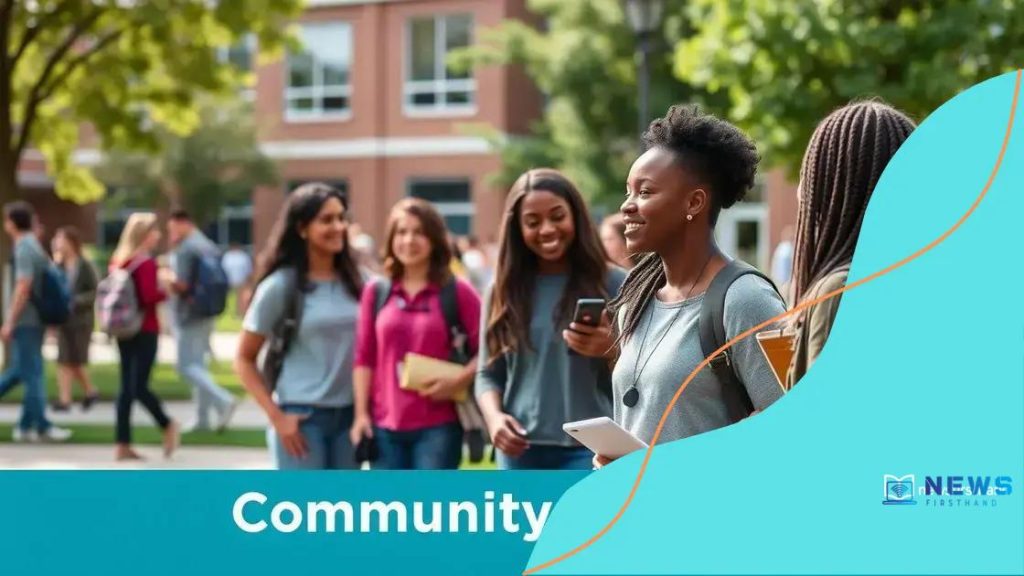Free community college for all: A game changer for education

Free community college initiatives eliminate tuition costs, making higher education accessible, boosting local economies, and providing a skilled workforce, despite challenges like funding sustainability.
Free community college for all is a bold initiative that aims to make higher education accessible to everyone. Have you ever thought about how this could change lives and communities? Let’s dive into the potential impacts and benefits.
Understanding the concept of free community college
Understanding the concept of free community college is essential to grasp how it can benefit students and communities alike. At its core, this initiative aims to eliminate tuition fees at community colleges, making higher education accessible to everyone. This access can significantly impact students’ futures, providing them with the tools they need for successful careers.
What is Free Community College?
Free community college refers to programs that cover the tuition costs for eligible students attending community colleges. This initiative is designed to reduce financial barriers, allowing more individuals to seek higher education without the burden of student debt. Many states have already begun implementing these programs to promote education and workforce development.
Benefits for Students
Offering free community college can lead to various benefits for students. Here are a few key points:
- Increased Enrollment: More students are likely to enroll in college when tuition is free.
- Diverse Opportunities: Students can explore different career paths without the financial pressure.
- Skill Building: Access to education enables individuals to gain valuable skills that meet job market demands.
Additionally, students who attend community colleges often receive personalized support and smaller class sizes. This environment fosters academic growth, helping students succeed in their educational pursuits. With the availability of open-access programs, many are finding the courage to further their education and enhance their resumes.
In conclusion, understanding the concept of free community college reveals its importance in creating a more equitable educational landscape. This initiative not only allows students to pursue their aspirations without financial restraints but also strengthens communities by cultivating a well-educated workforce.
The benefits of free community college for students
The benefits of free community college for students are vast and impactful. This initiative is designed to remove financial barriers, making education more accessible for everyone. Through free tuition, students can explore their educational goals without the heavy burden of debt.
Financial Relief
One of the most significant benefits is financial relief. Many students worry about how to pay for college. With free community college, they can focus on their studies rather than stressful financial obligations. This allows for a more enriching educational experience.
Access to Higher Education
Moreover, free community college increases access to higher education. More individuals can enroll, leading to a more educated workforce. Students from various backgrounds can take advantage of these opportunities. This diversity enriches the college experience and prepares them for a global job market.
- Improved Career Options: With a college education, many students tap into better job opportunities.
- Skill Development: Community colleges often focus on practical skills that employers seek.
- Support Services: Many community colleges offer academic and counseling services to help students succeed.
Furthermore, this initiative encourages lifelong learning. As students gain confidence in their abilities, they may pursue further education or training. This empowerment can lead to personal growth and community involvement. The impact of free community college extends beyond academics, fostering a sense of community engagement.
In addition to academic benefits, students often develop valuable connections during their time at community colleges. Networking with peers and instructors can open doors to internships and job placement opportunities.
How free community college affects local economies

Understanding how free community college affects local economies is crucial in recognizing the broader impacts of this initiative. By providing access to education without tuition fees, communities can experience significant economic growth and development.
Boosting Local Employment
Free community college leads to an increase in the number of educated individuals in the workforce. This, in turn, helps attract businesses looking for skilled employees. As more people gain valuable skills, local companies can thrive, leading to job creation and lower unemployment rates.
Increased Consumer Spending
Moreover, as individuals complete their education, they tend to earn higher wages. This increase in income allows them to spend more within their communities. When students transition into well-paying jobs, they contribute to local economies by purchasing homes, cars, and other goods.
- Community Investments: More educated workers may lead to new businesses opening in the area.
- Enhanced Local Services: Increased spending can improve public services, like schools and infrastructure.
- Economic Stability: Higher employment rates offer a buffer against economic downturns.
In addition, free community college can stimulate economic diversity. As more people engage with different educational programs, they bring varied skills and experiences into the job market. This diversity can lead to innovation and a more dynamic local economy.
Furthermore, when residents are better educated, they often engage more in local governance and community activities. This engagement can lead to improved local policies and services, which fosters a healthier community overall. The ripple effects of free community college initiatives can profoundly influence not only individual lives but entire local economies.
Challenges and criticisms of free community college
While there are many benefits, the challenges and criticisms of free community college are important to address. Critics often raise concerns regarding funding, accessibility, and educational quality.
Funding Issues
One major challenge is the funding of free community college programs. Many worry that the costs associated with these programs could lead to increased taxes or reallocating funds from other essential services. Critics argue that sustainable funding solutions need to be identified to ensure long-term viability.
Equity in Access
Accessibility is another concern. Some argue that not all students have equal access to these programs. While tuition may be free, students might still face costs related to books, transportation, and housing. This can create disparities, leaving low-income students at a disadvantage.
- Limited Program Availability: Not all community colleges offer the same range of programs, which can affect available choices.
- Awareness and Understanding: Many prospective students may not be aware of free community college options or how to access them.
- Support Services: The quality of support services can vary widely, affecting students’ success.
Additionally, there are concerns about the quality of education provided. Some critics argue that with increased enrollment, community colleges may struggle to maintain a high standard of education. Larger class sizes and limited resources can affect the teaching and learning experience.
Despite these criticisms, advocates emphasize that addressing these challenges is necessary to realize the full potential of free community college. By finding effective solutions, such as improved funding strategies and enhanced support services, the program can better serve communities and students alike.
Real-life success stories from free community college initiatives
Real-life success stories from free community college initiatives provide inspiring examples of the positive impact these programs can have on individuals and communities. These stories highlight how accessible education can transform lives and foster economic growth.
Student Journeys
Many students who have benefited from free community college illustrate the initiative’s potential. For instance, Maria, a single mother, utilized a free community college program to pursue her nursing degree. By removing tuition costs, she was able to balance her studies with parenting, ultimately achieving her dream job and improving her family’s financial situation.
Community Impact
These initiatives also strengthen local communities. For example, in a small town, a newly established free community college program led to increased enrollment rates. This surge allowed individuals from diverse backgrounds to gain education and skills. As a result, local businesses experienced a boost in workforce quality, meeting the demand for skilled labor.
- Increased Graduation Rates: Many community colleges report higher graduation rates since implementing free tuition programs.
- Enhanced Job Readiness: Graduates often find employment quickly due to the skills acquired, benefiting both themselves and the economy.
- Diverse Student Populations: Free access attracts a broad range of students, enriching the educational environment.
Additionally, success stories often include individuals who have gone on to four-year universities after attending community college. For example, John, who pursued computer science, transferred to a major university after completing his associate degree. This progression showcases how free community college can serve as a stepping stone toward advanced education.
In conclusion, real-life success stories from free community college initiatives emphasize the importance of accessible education. They highlight transformations not only for students but also for communities as a whole, paving the way for a brighter future.
In conclusion, free community college initiatives have the potential to transform lives and strengthen communities. By providing accessible education, students can pursue their dreams without the burden of debt. This leads to skilled workers entering the job market, which boosts local economies. Real-life success stories show how individuals have thrived thanks to these programs. While there are challenges to address, the benefits outweigh the drawbacks, making free community college a vital opportunity for many.
FAQ – Frequently Asked Questions about Free Community College Initiatives
What is free community college?
Free community college refers to programs that waive tuition costs for students, making higher education accessible to all.
How does free community college benefit local economies?
It boosts employment by creating a skilled workforce, leading to increased consumer spending and local business growth.
Are there any challenges associated with free community college?
Yes, challenges include funding sustainability, ensuring equitable access, and maintaining educational quality.
Can I still get financial aid if I attend a free community college?
Yes, students may still qualify for financial aid for living expenses, books, and other costs, even if tuition is covered.





